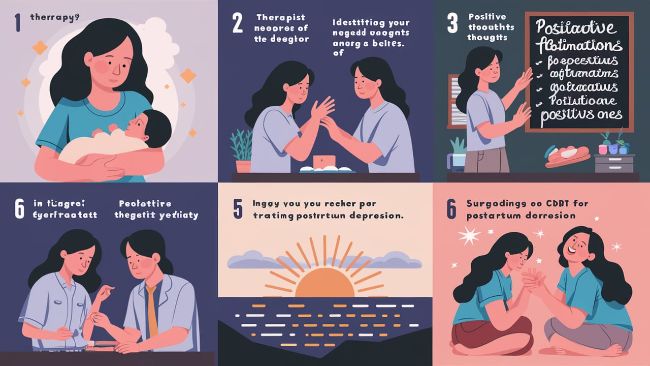In the throes of postpartum depression (PPD), your own mind can feel like a hostile territory. A constant barrage of negative thoughts leaves you feeling exhausted, guilty, and hopeless. You long for a practical tool, a concrete map to navigate your way out of the fog.
Enter Cognitive Behavioral Therapy (CBT).
Unlike some forms of therapy that delve deep into your past, CBT is a present-focused, skills-based approach that is one of the most effective treatments for PPD. It’s less like an archaeological dig and more like a hands-on workshop for your brain.
The core principle is revolutionary: you can change how you feel by changing how you think and what you do.
This article is your step-by-step beginner’s guide. We will walk you through the fundamental techniques of CBT, tailored specifically for the postpartum experience. While this guide is not a substitute for working with a trained therapist, it will give you the foundational tools to start challenging PPD’s narrative and reclaiming your mental space, one thought at a time.
The Foundation (Step 0): Understanding the CBT Triangle
Before you can use the tools, you need to understand the machine. CBT is built on the “CBT Triangle,” which shows how our thoughts, feelings, and behaviors are inextricably linked.
- Thoughts: What we think affects how we feel and act.
- Feelings (Emotions): How we feel affects what we think and do.
- Behaviors (Actions): What we do affects how we think and feel.
[Insert a simple, clear infographic of the CBT Triangle here. It should have “THOUGHTS” at the top, “FEELINGS” at one bottom point, and “BEHAVIORS” at the other, with arrows flowing between all three.]
In PPD, this creates a vicious downward spiral:
- The Situation: Your baby wakes up for the third time in two hours.
- Thought: “I can’t do this. I’m the only one who can’t handle it. I’m failing.”
- Feeling: A wave of intense hopelessness, anxiety, and shame washes over you.
- Behavior: You feel paralyzed. You go through the motions of caring for the baby with a sense of numb detachment, then collapse into bed and cry, ignoring your own need for food or water.
This behavior (withdrawal) reinforces the thought (“I can’t cope”), which makes you feel even more hopeless. CBT teaches you how to break this cycle.
Step 1: Become a Thought Detective (Catching Your ANTs)
The “C” in CBT stands for Cognitive. Your first job is to become a detective of your own thoughts. PPD floods your brain with what CBT founder Dr. Aaron Beck called Automatic Negative Thoughts (ANTs). They are quick, powerful, and feel 100% true.
The goal of this step is simply awareness. You need to learn to hear the thoughts, to separate them from yourself.

A Practical Tool: The Thought Record
A simple thought record is your detective’s notebook. It helps you catch ANTs in the wild. It can be a note in your phone or a physical journal with a few columns:
- Situation: What was happening right before you felt a strong negative emotion?
- Emotion(s): What did you feel? (Sad, anxious, angry, guilty). Rate its intensity from 0-100.
- Automatic Thought(s): What specific words or images went through your mind?
Example:
| Situation | Emotion(s) | Automatic Thought(s) |
|---|---|---|
| My partner came home and I hadn’t showered or cleaned the kitchen. | Shame (90), Anxiety (70) | “He thinks I’m lazy and useless. I’m a mess. I can’t even manage the basics.” |
Just writing it down is a powerful act. It externalizes the thought so you can look at it, instead of just from it.
[Insert a simple graphic here showing a sample Thought Record table.]
Step 2: Put Your Thoughts on Trial (Checking the Evidence)
Once you’ve caught an ANT, you don’t just accept it as fact. You put it on the witness stand and cross-examine it.
The “Aha!” Moment: Thoughts Are Not Facts
This is the single most important lesson of CBT. Your thoughts are mental events, not objective truths. The thought “I am a failure” is a symptom of depression, not a fact about your character.
To check your thought, ask yourself these questions:
- What is the hard evidence FOR this thought? (Feelings are not evidence!)
- What is the hard evidence AGAINST this thought? (e.g., “The baby is fed, warm, and safe. I’ve survived every hard day so far.”)
- Am I falling into a common “Thinking Trap”? (See below).
- What would I tell my best friend if she said this to me?
- Is there a more balanced or compassionate way to see this situation?
Common PPD Thinking Traps (Cognitive Distortions)
Depression makes our brains lazy. It relies on mental shortcuts that are almost always negative. Here are a few to watch for:
| Thinking Trap | What It Is | Postpartum Example |
|---|---|---|
| Mind Reading | Assuming you know what others are thinking without any real proof. | “The other moms in the playgroup all think I’m a mess.” |
| Fortune Telling | Predicting the future will be negative without considering other outcomes. | “I’ll never sleep through the night again. I’m going to feel this exhausted forever.” |
| All-or-Nothing Thinking | Seeing things in absolute, black-and-white terms. No shades of gray. | “I had to supplement with formula. I have completely failed at breastfeeding.” |
| Emotional Reasoning | Assuming that because you feel something, it must be true. | “I feel like a bad mom, so I must be one.” |
| Overgeneralization | Taking one negative event and turning it into a never-ending pattern of defeat. | “The baby cried the whole time we were at the store. We can never go out again.” |
Step 3: Re-write the Script (Creating a Balanced Thought)
After you’ve cross-examined your ANT and seen its flaws, the final cognitive step is to create a more balanced, compassionate, and realistic thought to replace it.
This is NOT about “positive thinking” or lying to yourself. It’s about finding the truth.
Let’s go back to our Thought Record example:
- Original ANT: “He thinks I’m lazy and useless. I’m a mess. I can’t even manage the basics.”
- Checking the Evidence: “He has never called me lazy. In fact, yesterday he said he was amazed by how much I do. The ‘basics’ now include keeping a tiny human alive 24/7, which is not a ‘basic’ task. I feel like a mess, but feelings aren’t facts.”
- Balanced Thought (The New Script): “I’m having the thought that my partner thinks I’m lazy. It’s understandable I feel this way because I’m exhausted and overwhelmed. The reality is that I am doing an incredibly difficult job, and my worth isn’t determined by a clean kitchen. I am doing my best.”
Can you feel the difference? The new thought doesn’t deny the struggle, but it’s infused with compassion and truth.
Step 4: Use Action to Create Motivation (Behavioral Activation)
The “B” in CBT stands for Behavioral. Depression kills motivation and makes you withdraw from life, which only makes the depression worse. Behavioral Activation breaks this cycle by flipping the script.
The Principle: You don’t wait to feel motivated to act. You act in small ways to create the feeling of motivation and accomplishment.
Key Takeaway: In PPD, your “feeler” is temporarily broken. Use your “doer”—even if it’s on low power—to help fix it.
The key is to start ridiculously small.
- Instead of “Exercise,” your goal is “Walk to the mailbox and back.”
- Instead of “Connect with friends,” your goal is “Text one friend ‘hello’.”
- Instead of “Practice self-care,” your goal is “Brush your teeth.”
These aren’t your forever goals. They are tiny sparks designed to light a fire. Each one you complete sends a message to your brain: “I can do things. I am not helpless.” This builds an upward spiral.
Putting It All Together: Sarah’s Journey
Let’s watch how a new mom, Sarah, could use these steps in a real moment of crisis.
- Step 0 (The Situation): Sarah is trying to get her 6-week-old to latch for a feeding. The baby is fussy and keeps pulling away.
- Step 1 (Catch the ANT): Sarah feels a surge of panic and despair. She notices the thought: “He hates me. My body is failing him. I’m a complete failure at the one thing I’m supposed to be able to do.”
- Step 2 (Check the Thought): She takes a deep breath and puts the thought on trial. Evidence against? “He doesn’t have the brain capacity to ‘hate’ me. He’s a baby. He’s probably just uncomfortable or tired. My body grew him for 9 months; it’s not a failure. Is this All-or-Nothing thinking? Yes.”
- Step 3 (Change the Thought): She forms a balanced thought: “This is really frustrating and hard. It’s okay to be upset. We are both new at this, and we will figure it out together. His fussiness isn’t a judgment on me.”
- Step 4 (Behavioral Activation): Instead of giving up and spiraling into tears (her old behavior), she chooses a small, positive action. She decides to take a 5-minute break, swaddle the baby, and then try a different feeding position. She also makes a note to call the lactation consultant’s hotline later.
By using the CBT steps, Sarah navigated a crisis moment without falling into the depressive pit. This is the power you build, one moment at a time.

Frequently Asked Questions (FAQ)
Q1: Is this guide a replacement for actual therapy?
No. This guide is a starting point. CBT is most effective when guided by a trained therapist who can personalize the techniques, hold you accountable, and help you navigate the nuances of your own mind. Think of this as a first-aid kit, not a substitute for a doctor.
Q2: This seems like a lot of work. How can I do this when I’m so exhausted?
It is work, but it’s productive work. Start small. Don’t try to do it all at once. Maybe just practice Step 1 for a week—simply noticing your thoughts. Be compassionate with yourself. Any effort you make is a victory against depression.
Q3: What if I try to challenge a thought and I still believe the negative one?
That’s completely normal, especially at first. The negative pathways in your brain are well-worn. It takes time and repetition to build new ones. Don’t aim for 100% belief in the new thought. Aim for 10% or even 5%. Just cracking the door open to another possibility is a huge win.
You Are the Expert on You
Postpartum depression can make you feel like a stranger in your own mind. It whispers lies and presents them as facts. Cognitive Behavioral Therapy gives you a megaphone to talk back.
This step-by-step process is a way to reclaim your power. It teaches you that while you cannot always control your first thought, you have the ability to choose your second one. And in that choice lies the path back to yourself. Be patient, be compassionate, and take it one step at a time.
Disclaimer: This guide is for informational purposes only and is not a substitute for professional medical or psychological advice. If you are struggling with symptoms of postpartum depression, please contact a qualified healthcare provider or a crisis hotline immediately.
